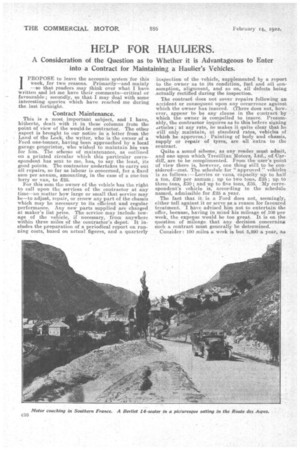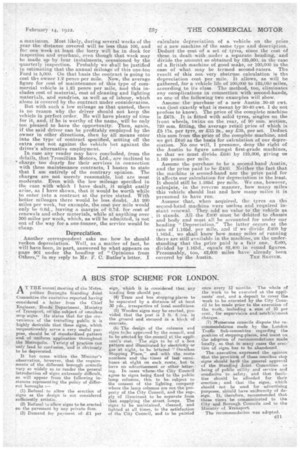HELP FOR HAULIERS.
Page 14

Page 15

If you've noticed an error in this article please click here to report it so we can fix it.
A Consideration of the Question as to Whether it is Advantageous to Enter into a Contract for Maintaining a Haulier's Vehicles.
IPROPOSE to leave the accounts system for this week, for two reasons. Primarily—and mainly —so that readers may think over what I have. Written and let me have their comments—critical or favourable; secondly, so-that I may deal with some interesting queries which have reached me during the. last fortnight..
. . . .
Contract Maintenance. _
This is a most important subject, and I have, hitherto, dealt with it in these columns from the point of view of the would-be contractor. The other aspect is brought to our notice in a letter from the Land of the Leek, the writer, who is the owner of a Ford. one-toim saving aving been approached by a local garage proprietor, who wished to maintain his van for him. The scheme of maintenance, as outlined on a printed circular which this particular correspondent has sent to me. has, to say. the least, its good points. The contractor undertakes to carry out all -repairs, so far as labour is concerned, for a fixed sum per annum amounting, in the ca-se of a one-ton
lorry or van, to 225. . For this sum the owner of the vehicle has the right to call upon the services of the contractor at any time—no matter how large or small that service may be—to adjust, repair, or renew any part of the chassis which may be necessary to its efficient and regular performance. Any new parts supplied are charged at maker's list price. The service may include towage of the vehicle, if necessary, from anywhere within three miles of the contractor's depot. It includes the preparation of a periodical report on running costs, based on actual figures, and a quarterly. inspection of the vehicle, supPlemented by a report to the owner as to its condition, fuel and oil vonsumption, alignment, and so on, all defects being .actually rectified during the inspection.
The contract does not cover repairs following an azcident or consequent upon any occurrence against which the owner has insured. •(There does not, however, appear to be any clause in the contract by which the owner is compelled to insure. Presumably, the contractor inquires as to this before signing drticles ; at any rate, he makes it quite clear that he will only maintain, at standard rates, vehicles of which he approves.) Painting of body and chassis, supply or repair of tyres, are all .extra to the contract.
Quite a sound &acme, as any reader must admit, and one upon which Tresillian Motors, Ltd., of Cardiff, are to be complimented. From the user's point of view there is, however, one thing still to be considered—cost. The schedule for " approved " vehicles is as follows:—Lorries or vans, capacity up to half a ton, £20 per annum ; up totwo tons, £25; up to three tons, 230; and up to five tons, £35. My correspondent's vehicle is, according to the schedule named, admissible for 225 a year.
The fact that it is a Ford does not, seemingly, either tell against it or serve as a reason for favoured treatment. -I have advised him not to entertain the offer, because, having in Mind his mileage of 100 per week, the expepse would be too great. It is on the question of mileage that any decision concerning such a contract must generally be determined.
Consider : 100 miles a week is but 5,200 a year, 3.0 a maximum. Most likely, during several weeks of the year the distance covered will be ieas than 100, and foe one week at least the lorry will be in dock for inspection and overhaul, even though that week may be made up by four instalments, occasioned by the quarterly inspection. Probably we shall be justified in estimating that the annual mileage of this one-ton Ford is 5,000. On that basis the contract is going to cost the owner I:2 pence per mile. Now, the average figure for cost of maintenance of this type of commercial vehicle is 1.23 pence per mile, and this includes cost of material, cost of cleaning and lighting materials, and sundries, as well as of labour, which alone is covered by the contract under consideration.
But with such a low mileage as that quoted, there is no reason why the driver should not keep the vehicle in perfect order. Re will have plenty of time for it, and, if he is worthy of the name, will be only too pleased to have the opportunity. Then, again, if the said driver can be profitably employed by the owner in other directions, then by all means enter into the type of contract specified, setting off the extra cost not against the vehicle but against the driver's alternative employment.
In case any reader may have concluded, from the details, that Tressillian.Motora, Ltd., are inclined to
• charge too dearly for their services in connection with these maintenance contraeta, I hasten to state that I am entirely of the contrary opinion. The charges are not merely reasonable, but are most moderate. Even with the low mileage specified in the case with which I have dealt, it might easily arise, as I have shown, that it would be worth while to enter into a contract at the price Stated. With better mileages there would be less doubt. At 200 miles per week, for example, the cost per mile would only be 0.6d., leaving a margin of 0.7d for cost of renewals and other materials, while at anythin over 300 miles per week, which, as will be admitted, is not out of the way for a, one-tonner, the service would he cheap.
Depreciation.
Another correspondent asks me how he should reckon depreciation. Well, as a matter of fact, he will have been, in part, answered by what appears oht page 901 under the heading • of "Opinions from Others," in my reply to Mr. F. C. Butler's letter. _I calculate. depreciation. of a vehicle on the price, of a new machine of the same type and description. Deduct the cost of a set of tyrea, since the cost of these is dealt with under a separate heading, and divide the amount so obtained by 125,000, in the ease of a British machine of good make, or 100,000 in the case of what may be termed second-raters. The result of this not very abstruse calculation is the depreciation eclat per mile, it allows, as will be gathered, for a vehicle life of 100,000 to 125,000 miles, according to its class. The method, too, eliminates any complications in connection with second-hands, as one of the following two examples will show.
Assume the purchase • of a new Austin 30-40 cwt. van (just exactly what is meant by 30-40 cwt. I do not profess to know). The price of the complete machine is 2675. it is fitted with solid tyres, singles on the front wheels, twins on the rear, of 90 mm. section-, 720 mm. fitting, the average retail price of which is £5 17s. per tyre, or 235 2s., say .235, per set. Deduct this sum from the price of the complete machine, and we get 2640 as the basis for calculation of our depreciation. No one will, I presinne, deny the right of the Austin to figure amongst first-grade machines, so that we must divide £640 by 125,000, giving us 1.165 pence per mile. Assume the purchase to be a .second-hand Austin, and the price paid to he 2400. Neither the fact that the machine is second-hand nor the price paid for it affects our calculation for depreciation in the least. It should still he 1.165d. per mile. We can, however, calculate, in the reverse manner, how ninny miles this vehicle should last and how ninny miles it is presumed to have run. Assume that, when acquired, the tyres on the second-hand Machine. were useless and required instant renewal. They add no value to the vehicle as it stands. All the £400 must be debited to chassiS and body and must all be accounted for under our heading " Depreciation." The latter occurs at the rate of 1.165d. per mile, and if we divide 2400 by 1.165d., we shall know how many miles of running there are still available in the machine, on the under standing that the price paid is a fair one, £400, divided by 1.165d.' equals 82,400 in round figures. Presumably, too, 42,600 miles have already been covered by the Austin. THE SKOTCH.
































